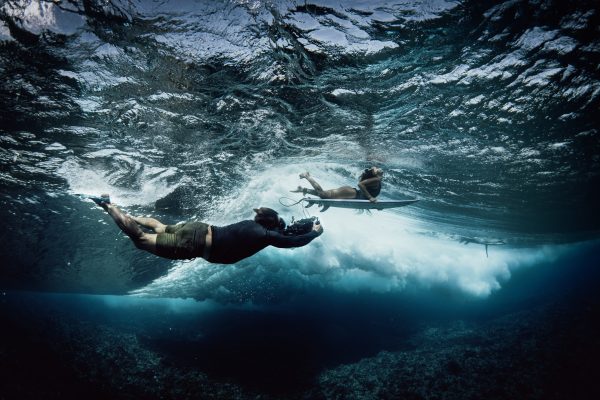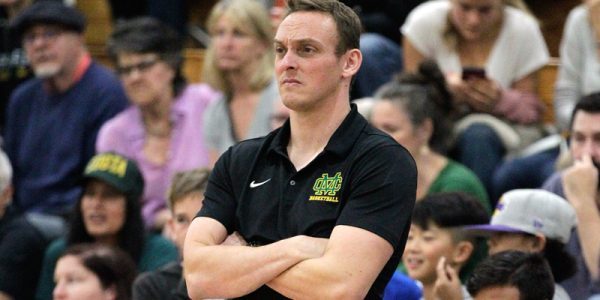Dolphins are increasingly present off the Palos Verdes coast, providing a closer glimpse of one of the ocean’s most mysterious, beckoning, and wildly social beings
by Mark McDermott
Dolphins have a way of changing the arc of a human life.
Eric Martin remembers the exact moment his life with dolphins began. It was 9 o’clock in the morning on October 28, 1984. Through his job as a guide at Marineland, he’d become acquainted with marine photographer Bob Talbot, who worked with the ACS/LA Gray Whale Census and Behavior Project that had just been established in Palos Verdes. That morning, Martin arrived at work and ran into Talbot, who was in a hurry. A pod of orcas had been spotted off the coast.
Talbot would later become famous, both as a photographer and as a director of such films as Free Willy, Flipper, Into the Blue, and Dolphin Story 2. But at the time, he was just another member of a certain tribe of avid people who spend as much time as possible in the company of marine mammals.
Martin, just out of high school, was both an animal lover and photo enthusiast. He started photographing birds around his hometown of El Segundo at the age of 10, and as a teenager volunteered as a photographer helping count bald eagles in Big Bear. Then, through his work at Marineland, Martin had begun learning about ocean life. Orcas are the apex predator of the oceanic food chain, and Martin had never seen one in the wild. He invited himself along for the ride.
Within minutes he found himself alongside Talbot, racing across Rocky Point in a 14 foot, inflatable dinghy. They were chasing a pod of orcas, who, although known as killer whales, are actually the largest species in the dolphin family.
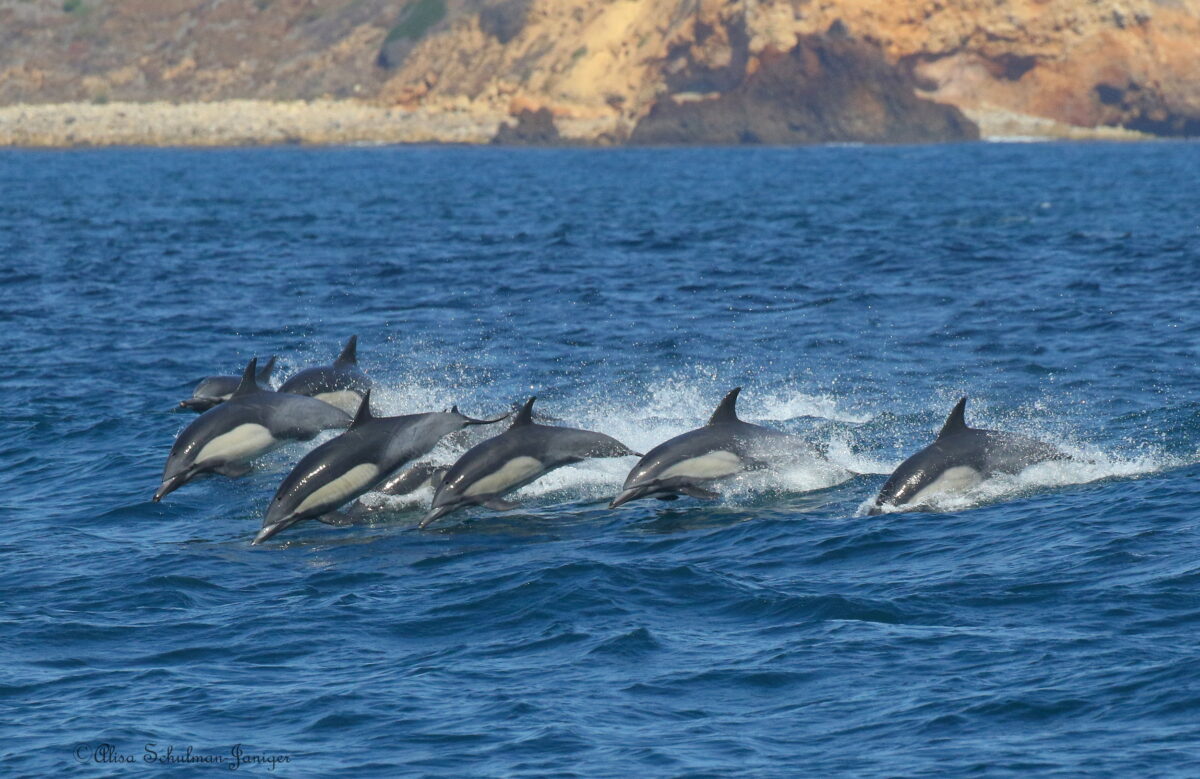
“We tracked down the orcas,” Martin said. “And my life took off with them. That just changed everything. Because from that moment on, I just wanted to know what was going on in the ocean.”
His timing was good. The waters of the South Bay have always been rich with marine life, but after the powerful El Niño of 1982-83, which pushed warmer waters up the California coast, the area grew thicker with marine mammals. Specifically, bottlenose dolphins began frequenting local waters.
“I always surfed, but there were no dolphins here in the ‘70s or early ‘80s, at all,” Martin said.
Marine biologist Alisa Schulman-Janiger, the founder of ACS/LA Gray Whale Census and Behavior Project, which is based at Point Vicente, in Palos Verdes, said prior to that El Niño, seeing a bottlenose dolphin locally was a rarity. The coastal bottlenose population ranged from Baja, Mexico to San Diego. Even more surprisingly, Schulman-Janiger said, was that later in the ’80s, two different La Niña events occurred, which once again cooled local waters. Yet the bottlenose dolphins remained.
The South Bay had become a seasonal home for the animals.
“That was not something you expected to be able to see at that time,” she said. “Definitely, with the El Niño of ’82-’83, bottlenose dolphins shifted up the coast, and then, when El Niño hooked over to La Niña, they didn’t go back down. Even the ones that moved up to Santa Barbara and San Francisco didn’t head back down when the water got colder. They found food.”
The dolphins have stayed. When the Gray Whale Census Project 40 years ago, a dolphin sighting was a rarity. Last year, during the six months in which observations of whales and other species occurred from the project’s perch on Point Vicente, dolphins were spotted almost every day.
“We were open 170 days between December and May,” Schulman-Janiger said. In those 170 days, we saw common dolphins on 147 days, and we saw bottlenose dolphins on 139 days. Those were our two species most often seen.”
In 1996, a young biologist named Maddelena Bearzi arrived in the LA area from her native Italy. She’d studied sea turtles in Mexico and dolphins in the Ionian Sea. But in coming to a vast metropolitan area she didn’t expect to be able to continue her observations of either species.
Bearzi had come to Los Angeles after she’d met her future husband, an American sailor. On one of their first sails out of Marina Del Rey, Bearzi was shocked to discover a sizable population of what she would come to call “cosmopolitan dolphins,” wild animals living in an urban area.
Something had happened to Bearzi the very first time she came face to face with a dolphin, back in the Ionian Sea off the Greek Isles. All the rigor of her scientific training dropped away, overtaken momentarily by a childlike sense of wonder.
“There is something there that I have not seen in my work with other animals, a kind of knowing or consciousness,” she later wrote in her memoir, Dolphin Confidential: Confessions of a Field Biologist. “It feels like they are as aware of us as we are of them.”
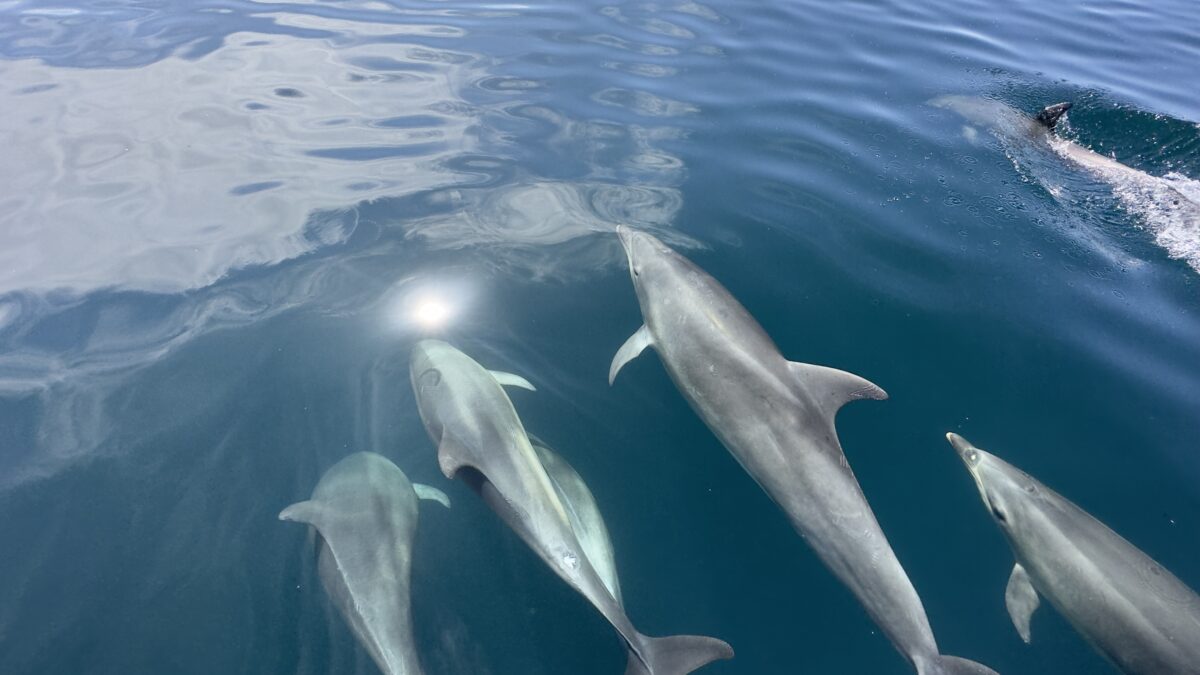
After encountering bottlenose dolphins near Los Angeles, Bearzi gave her life to their study. Bearzi launched the first-ever long term study of this population of bottlenose dolphins. Almost 30 years later, she is still studying these dolphins, a population she and a network of marine biologists from Mexico to Northern California believe numbers about 460 animals. Her wonder has never abated, but instead grown.
“What stands out is the similarities they have with our own species, probably more than many of us want to admit,” said Bearzi, who now operates the Ocean Conservation Society out of Marina Del Rey. “The bottlenose dolphins live in a very complex society. They are very large brained animals. Like we find in humans, the mother and calves have really, really strong bonds. And they have culture. They transmit information from one generation to the next, also something found in humans. They are very effective in their communication.
“They deceive each other like we do, they imitate each other like we do. They do many things that are very similar to what we do.”
Martin joined the staff at the Roundhouse Aquarium in 2001 and eventually became its co-director. Lynne Gross, a board member for the Roundhouse Aquarium, said Martin is the South Bay’s homegrown biologist.
“He still surfs every day,” Gross said. “Eric has gotten his knowledge through experience, and that is the best way to get it. I don’t know how many books he’s read on dolphins, but he’s out there, and he swims with them, and they come right up to his boat and introduce their babies to him. He’s really just out there with them, and he knows the practical side of it. His knowledge is firsthand.”
Martin and Schulman-Janiger are in some sense marine animals themselves. They have shared adventures across four decades, out in the ocean observing orcas, gray whales, blue whales, ever-present sea lions, and every kind of marine wildlife. Among these many wonders, Martin’s bond with bottlenose dolphins still sometimes manages to startle Schulman-Janiger.
She recalled Martin telling her about a dolphin who’d become particularly friendly with him, racing to his boat every time he saw it, literally bumping up against the bow.
“I didn’t believe him,” she said. “I mean, I didn’t disbelieve him, but I thought that would be super unusual for a dolphin to consistently do something like that. Until I actually saw that animal.”
They were out in his boat and Martin jumped up and pointed.
“It’s from this group,” he said.
“That one over there?” Schulman-Janiger said.
“Wait for it,” he said. “Wait for it.”
“Sure enough, it came right up against us, and held its back out of the water,” she recalled. “It put its back up against the bow, as if it was requesting to be touched. It was just really interesting. I had that experience with him multiple times.”
Martin said the dolphin was a male he’d named Mr. K (due to a scar that reminded him of the Circle K gas station logo), who frequently traveled with a juvenile named Ghost.
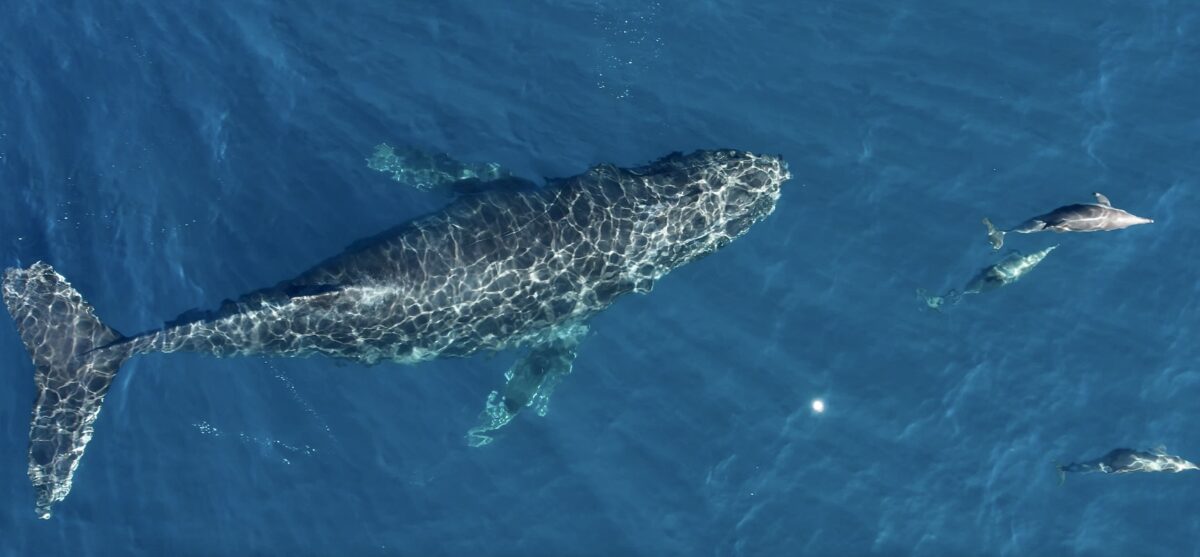
“Those two would make a mad rush for my boat, always,” he said. “Mr. K would turn on his side, and do a barrel roll. I would turn my engine off and they would just circle and circle, until they got called away.”
Martin has gotten a strong sense that even when the entire pod is not present, they remain connected with one another. Dolphins, along with the whistling, squeaking, and clicking noises we can hear them make, emit high frequency ultrasound waves and then listen to the echoes that bounce off objects in the water. This is called echolocation, and it enables them to find where other dolphins are and — in the case of Mr. K and Ghost, Martin believed — what they are doing, and what they’re saying.
“There’s a lot of communication going on out there,” Martin said.
Dolphin communication is an area of study in which much has been learned in recent decades, yet much mystery remains. It is clear dolphins are able to recognize not only each other, by sound and likely sight, but also individual human beings. This interspecies recognition breaks down what would seem to be an impenetrable border between humans and dolphins.
“When you recognize the individual, it’s much more than, ‘Oh, it’s a coastal bottlenose dolphin,” Schulman-Janiger said. “It puts it on a much more personal basis….It feels like, ‘There’s a bottlenose dolphin, the people of the sea.’ I don’t think of them as lower animals, or separate, but equal in a way. They are intelligent beings living their lives.”
Earlier this year, the Roundhouse Aquarium launched an effort to better understand bottlenose dolphins. Just as dolphins tend to draw scientists deeper into their studies of ocean life, the Dolphin Project intends to better acquaint students, young and old alike, with this highly intelligent, social species that seems to beckon us to broaden our ideas of what is possible. No better ambassadors of the deep exist than the bottlenose dolphins. The hope is that if we better understand dolphins, we will better protect the marine environment in which they live, and to which we are inextricably linked.
The project is based, in a large part, on the hundreds of hours of drone footage Martin has obtained of the bottlenose population. But it is also something beyond documentation, an invitation of sorts that seems to naturally link our species with dolphins, a connection to a world of wonder.
“That connection, whatever it is, is something that is really hard to explain,” Martin said. “You could be the grumpiest person, you could be going through something in your life, you could be depressed – a dolphin will always make your frown a smile. No matter what, no matter how low you are, it’ll somehow put that little bit of sunlight into your heart. I can’t explain it. It’s just what it is.”
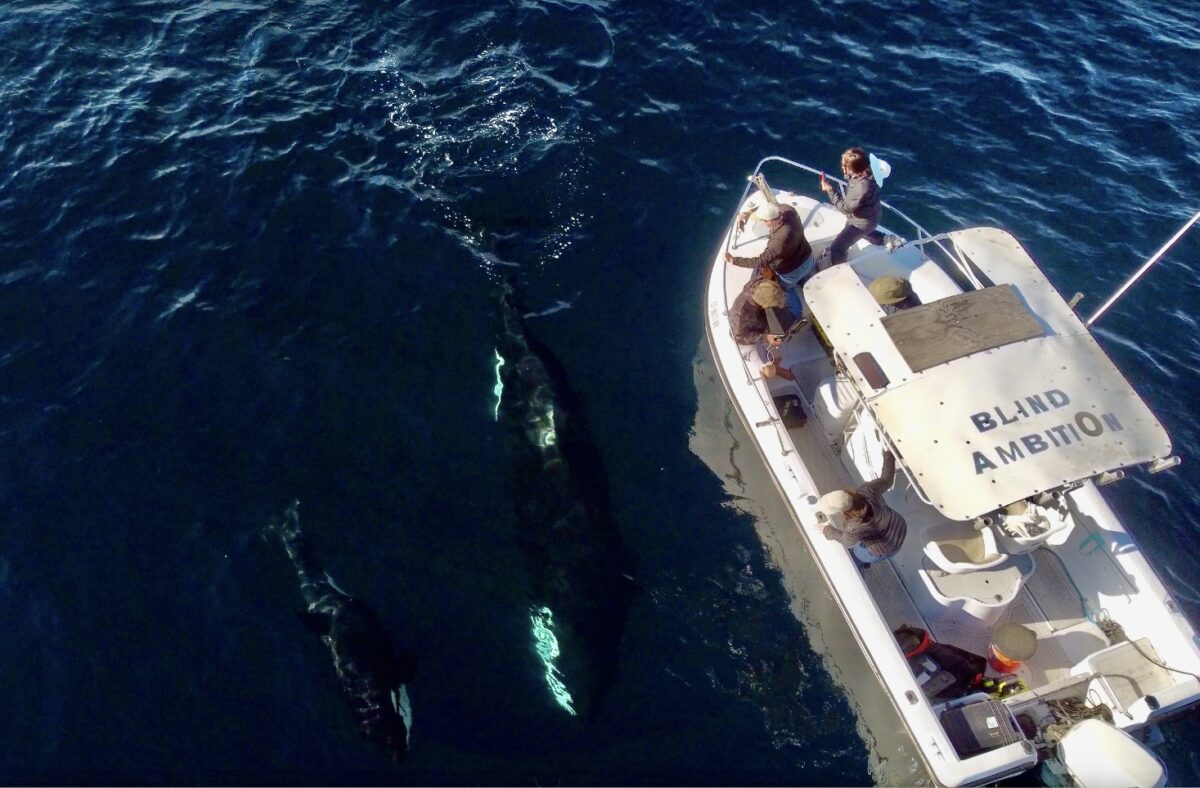
People of the sea
The study of marine wildlife for most of scientific history has lagged behind the study of terrestrial species for an obvious reason: they spend their lives mostly underwater.
Dolphins, like whales, were mysterious, almost mythical creatures across most of human history. The special connection people feel for dolphins goes back to the very beginning of that history. The ancient Greeks called dolphins “hieros ichthys” which means “sacred fish,” and gave them rights under law; the murder of a slave was legal, but the killing of a dolphin was punishable by death. On the opposite side of the world, the Māori people of New Zealand and the South Pacific likewise held dolphins to be “tapu,” or sacred beings, possessing a powerful lifeforce, unusual intelligence, compassion, and consciousness.
Aristotle, considered by many as the world’s first scientist, in the 4th Century B.C. made some observations about dolphins that proved prescient – that they bear and nurse their young similarly to humans, breathe air, and communicate by underwater sounds. Four centuries later, in A.D. 77, the Roman commander and naturalist Pliny the Elder, in his Naturalis Historia, widely considered the first scientific compendium in history, wrote a chapter entitled “Human Beings Who Have Been Beloved By Dolphins.” Pliny recalled an instance that famously occurred during the reign of Emperor Augustus in which a dolphin befriended the son of a poor man. The boy would walk along the shore on his way to school and call out for the dolphin, who would invariably emerge from the deep, and they would swim together.
“This happened for several years, until at last the boy happened to fall ill of some malady, and died,” Pliny wrote. “The dolphin, however, still came to the spot as usual, with a sorrowful air and manifesting every sign of deep affliction, until at last, a thing of which no one felt the slightest doubt, he died purely of sorrow and regret.”
Perhaps no people on the planet, however, were more closely aligned with dolphins than the Chumash, the tribe that up until the Spanish conquest of California populated both the Channel Islands and the mainland along the Santa Barbara Channel. The Chumash regarded their connection to dolphins not only as spiritual, but familial. In the Chumash creation myth, they overcrowded their place of origin, Limuw, known now as Santa Cruz Island, and the Earth Mother, named Hutash, created a rainbow bridge for them to cross to the mainland. Some of the people, while crossing, became so enthralled with the fog-shrouded ocean below that they fell in. Hutash came to their rescue, transforming them into dolphins so they would not drown, and to this day the small remaining population of Chumash consider dolphins as kin – so much so, that they have successfully blocked several projects that would harm dolphins, including a PG&E project that intended to use 250-decibel sonar blasts in the channel to create a seismic map to detect a fault lines. Dolphins, with their extreme sonic sensitivity, would inevitably have suffered from such an onslaught. These dolphins, a tribal leader told the California Coastal Commission, were family. “They mourn the death of their loved ones just like you do. No one has the permit to take lives.”
It was no overstatement to say that dolphins mourn their losses. The Dolphin Project began because Martin witnessed such an instance.
Just after Mother’s Day in May, 2022, Martin received a call from Schulman-Janiger. Whale watchers at the Census Project at Point Vicente had witnessed a bottlenose dolphin carrying her dead calf on her head. In 2018, an orca named Tahlequah had been observed carrying her dead calf for 17 days, traversing 1,000 miles up the West Coast. But such behavior had only rarely been witnessed among dolphins.
Martin raced up to Palos Verdes and launched his drone. Soon, he found her, a coastal bottlenose dolphin, moving slowly, carrying a pale, lifeless calf. She was accompanied by two and sometimes three other dolphins. Eventually, she carried the calf into the thick kelp forest that grows off the PV coast.
“It was like a dolphin mourning at church,” Martin said. “It was this tall, cathedral kelp. The water was clear and it was hard for me to explain, but the mom would pick it up and drop it, pick it up and drop it, and then they would have this weird lineup right outside the kelp bed. It reminded me of a funeral ceremony. It was very touching.”
Martin filmed the mourning dolphins for three days. The mother continued to carry the calf, and the other dolphins moved slowly with her, never leaving her alone.
“That opened up a lot for me, about how these dolphins are so much like us in the empathy they have,” he said.
Martin hesitated to post the video because it seemed an almost private ceremony, but when he did, it went viral on social media and attracted widespread media attention. Martin started using a drone to observe marine life in 2016. At first the drone was a helpful addition to his forays by boat, but over the years, he found himself using the technology more and more. While his footage of whales and dolphins are perhaps most striking, the larger cycles of the local ocean environment also emerge, such as the riot of seabirds that congregate to follow the seasonal grunion runs. Martin began to realize the drone was opening up a much broader vantage point for observation than had ever been available to him with just a boat, his own eyes, and a camera. Most powerfully, he was beginning to better understand the comings and goings of the coastal bottlenose dolphin population.
“Having drones really opened up a lot of their world to me,” Martin said. “It’s going to sound weird to say, but they really taught me a lot – you know, how family structures work, how tender they are, how they take care of each other, babysitting. I could go on and on.”
Before anyone ever called it as such, Martin came to understand that he was embarked on a dolphin project, if for no other reason than his knowledge of the coastal population was growing by leaps and bounds. He was beginning to see their life cycles, and to know their families. Martin’s footage is not simply documentation. It’s stunningly beautiful. He posts voluminously, and to see all this imagery of dolphins, whales, birds, fish, against the flowing blue backdrop of the Pacific, and the daily dramas of the food chain at work along the coast, is to expand one’s awareness of just what the South Bay really is.
The dolphins are the stars of this show. Last summer, the Roundhouse Aquarium board of directors came to the realization that Martin’s growing body of work on dolphins had both scientific and educational significance.Thus was born The Dolphin Project.
“Our final objective here is to keep the ocean clean,” Gross said. “Dolphins are really like our canaries in the coal mine. They don’t have a lot of enemies. They live a long life, up to 60 years, and they take good care of their children. If they are dying, or getting sick, or getting welts on their bodies, it is probably because there is something wrong with the ocean. So we want to keep their habitat clean for them, but also keep the habitat clean for ourselves…It’s a connection. We are trying to use dolphins to make a connection with people for the environmental benefit of both.”

Among dolphins
Two distinct populations of bottlenose dolphins travel the California coast. The coastal bottlenose are so named because they generally stay within a half mile of the coast, and often much closer, frequently feeding and playing right at the surf break nearest the shore. The offshore bottlenose ecotype ranges from a mile out all the way out to the deeper waters off the continental shelf, as far as 300 miles out. The two populations look almost identical, with blue-gray coloring, each between 6 and 13 feet long, weighing between 300 and 1,400 pounds. They possess different skull shapes, and diets.
Martin has identified three different groups of coastal bottlenose dolphins who live part of the year in the South Bay. Each group consists of six to eight animals, though, in keeping with dolphin cultures everywhere, the groups intermix and individuals swap in and out. This is because dolphins live within what scientists call a “fission-fusion” society, which science writer Susan Casey has likened to “people milling around at a cocktail party.” Casey writes in her book, Voices in the Ocean: A Journey into the Wild and Haunting World of Dolphins, that these fluid societies are unusual in the animal kingdom.
“This [is] a sophisticated arrangement, uncommon in nature, requiring the animals to recognize one another, form bonds, trade favors, recall past associations, and get along in unfamiliar circumstances,” Casey writes. “Scientists had wondered what factored into a dolphin’s decision to leave one group or join another; they discovered that dolphins bopped between social clusters for the same reasons humans might. A teenage dolphin swimming along with his mother, for instance, might defect to a band of teenage dolphins who were having raucous fun; females with calves liked to hang out together; mating pairs were mostly interested in one another. In dangerous situations or tricky hunting conditions these subgroups would merge back together into one larger pod. When the heat was off, they would drift apart again.”
Bottlenose dolphins appear regularly in local waters throughout the year, although Martin says they tend to disappear for a while late in the spring and early summer.
When they are local, Martin said, they appear to have certain areas they use for different reasons. Some areas are playgrounds. Some are socialization areas.
“We actually do have family units that live here, and use our area not just as a just birthing ground but actually throughout their lives,” he said.
He has seen and filmed them cooperatively feeding. Part of the reason dolphins are known to possess culture, including knowledge they pass down from generation to generation, is that different bottlenose dolphins in different parts of the world have different diets and ways of procuring their food.
“You might see them in some parts of the world in shallow water, hitting their flukes on the bottom, swimming in a circle, which puts up a mud fence around the fish within that area, kind of like bubble net feeding with humpback whales, except they make a mud plume in a circle,” Schulman-Janiger said. “A different technique for foraging in some areas is dolphins using sponges – they pick up a sponge, usually adult females, and put it on their beak, and then use that spunge to poke around in the sand and look for fish. The sponge is protecting them against stingrays.”
Dolphins locally don’t use a tool like this, but they do have their own techniques. Martin has often seen small groups work together to unravel a so-called “bait ball,” which is a tightly packed school of mackerel or sardines, and share in the proceeds once they break it apart.
“Our guys will find a bait ball, and it’s normally groups of three who work together,” he said. “Two of them will hang out on the side and one will use a little bit of a tail slap, and then all three will go through the bait ball at once, chomping up as many sardines as they can. And then they move on. They never consume all of the fish. It seems like they want to make sure when they come back there are still fish hanging around.”
If this meal planning for a future day sounds like a fanciful imagining of dolphins’ cognitive abilities, the emerging science regarding dolphin cognition has shown it is difficult to overestimate their ability to think. Their brains are larger than ours, but structured much differently.
John Roberts, the former chair and longtime board member of the Roundhouse Aquarium, is a biologist. He marvels at dolphin brains.
“They’re mammals like we are. Their anatomy is similar, but it has some important differences that allow them to adapt to living in the ocean,” Roberts said. “And there are some things that they have that we don’t. For example, when they sleep in the ocean, half of their brain sleeps, and the other half stays awake, and then it switches to the other hemisphere.”
Dolphins, almost like yogis, are conscious breathers. This is because their forebears, 55 million years ago, were land animals. They adapted to ocean living, and if they breathed automatically, as we do, they would drown underwater. Their brain allows them to always remain conscious.
Their brains may be more advanced than ours on a cellular level. They possess more of a specialized cell called von Economo neurons, which neuroscience has linked to higher levels of empathy and self-awareness. Scientists have found dolphins possess an individual sense of self – they can identify themselves in a mirror, studies have shown, and have a particularly advanced sense of playfulness. One dolphin trainer at a South African aquarium was stunned when a six month old bottlenose dolphin named Dolly pulled a trick on him. She saw the man smoking a cigarette and blowing smoke outside the tank, swam off to her mother, suckled, then returned to the window and blew a cloud of milk.
“Using one thing to represent something else isn’t just mimicking,” wrote ecologist Carl Savina in his book Beyond Words: What Animals Think and Feel. “It is art.”
Neuroscientist Lori Marino, who with her colleague Diana Reiss published a groundbreaking study demonstrating bottlenose dolphins’ ability to identify themselves in a mirror, walked away from lab work after her discovery in 2000 and vowed never to work with dolphins in captivity again. She told Casey, in Voices in the Ocean, that her investigations have left her to wonder if dolphins not only have a sense of self, but a more advanced one – a kind of superpowered empathy that extends not only beyond self, but species.
“When you look at their brain you can definitely see how this could be an animal that takes sociality to another level,” Marino said. “There is some sort of cohesiveness in them that I don’t think we get quite yet, but it accounts for a lot of the behavior that seems strange to us.”
Of course, this cohesiveness can be used against them, such as when dolphins are herded en masse to be slaughtered by Japanese fisherman, as documented in the 2011 documentary The Cove. But it also may account from some otherwise inexplicably generous behavior.
Bearzi witnessed an extraordinary example of this early in her field work, in the late ‘90s. She and her team were on their boat, observing a group of nine dolphins feeding close to shore. Suddenly, one of the males left the group, and took off due West, moving rapidly. The group turned and followed, and the researchers, surprised by this unusual movement, took off after the group. The dolphins took them three miles out, and then stopped to circle a dark object floating in the waves. As the biologists pulled closer, they realized it was a young woman, as she turned her head and weakly raised her hand, a gesture for help. As they pulled her aboard, they found a bag attached to her neck with her German passport and a suicide note, but she had apparently changed her mind, and, with the help of a group of bottlenose dolphins, was saved.
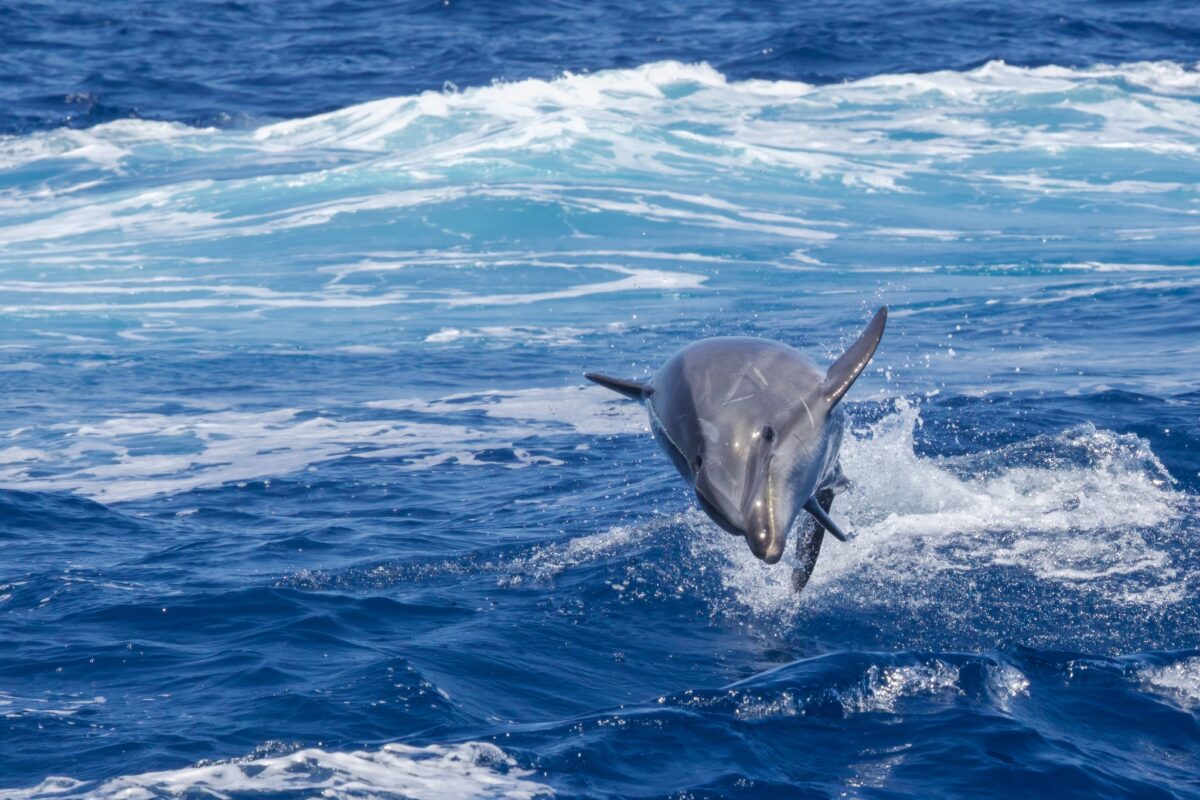
“There are many accounts of dolphins saving humans from death and disaster, either by guiding them to shore, fending off sharks, or helping them to remain afloat until help arrives. Many scientists think dolphins do not, in fact, save humans, because there is no hard scientific evidence to support these stories,” Bearzi wrote in Dolphin Confidential. “But today I witnessed coastal bottlenose dolphins suddenly leave their feeding activities and head offshore. And in doing so, they led us to save a dying girl, some three miles offshore. Coincidence?”
Two decades later, Bearzi’s field work continues. If dolphins seem ready to help us, she said, we need to be better at helping them.
“They’re very popular, and they’re very cute,” Bearzi said. “They attract our attention. We think they have these eternal smiles, but, you know, that doesn’t mean they are always happy. They are facing a lot of problems in the world, from climate change to overfishing to pollutants. We still have DDT and PCBs coming up in the water in Santa Monica Bay.”
Perhaps the single quality that compels Martin to do his work most is the way dolphins take care of each other. One of the dolphins he has tracked over the years he calls Scully, which is short for scoliosis, because she has a very apparent sideways curvature in her spine. In some species, such a deformity might result in a short life, particularly if the animal is not able to keep up with its group. But Scully, Martin has noticed, is never alone. He was particularly surprised two years ago when she showed up with a baby, which he’d assumed would not be possible for her.
“There is another dolphin she always hangs out next to,” Martin said. “It could be her mom, it could be a grandma, it could be an aunt. I don’t know. but it’s definitely another female, because the females normally like to hang out all together majority of the time. They just have these close bonds together. I don’t know. That dolphin just got my heart. Because sometimes, when people are different one way or another, we tend to shun them, maybe make fun of them. It’s just what human society does. And it seems in the marine mammal world, they bring them in. They’ll nurture them, and help feed them, if they have a hard time nursing themselves.”
Schulman-Janiger said dolphins, both in their similarities and differences from us, offer many lessons, and perhaps an invitation to better know our marine environment.
“This is not something that’s far away that you could never see in the wild,” she said. “It’s right here. If you are a person who swims, you might have a dolphin come right up close to you. A lot of surfers get experiences with dolphins. So yes, an ambassador for the deep would be a good descriptor for them. Seeing a dolphin jumping out of the water, body surfing, and then seeing people body surf, you just kind of think, ‘They are a lot like us.’ They just enjoy the water so much. And enjoy life.”
For more information on the ACS-LA Gray Whale Census and Behavior Project, which marked its 40th year of marine mammal observations off the PV Coast this year, see acs-la.org/gray-whale-census. PEN







